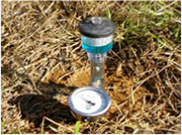Environmental Engineering is the Civil Engineering field that analyzes the occurrence, distribution, circulation, management and use of water and contaminants in nature and man-made systems. It also studies hauling and the control of contaminants in the water, solid substance, and atmosphere. The sustainable development of our society requires that the use of resources of such society does not put on risk the expected development in the future. The principles of protection, conservation, and best use of our natural and environmental resources are part of the responsibilities of a civil engineer.
The environmental engineer is responsible for the security of public health, protection of the environment, and reduction of risks caused by humans and nature. The responsibilities of a modern environmental engineer include water supply, management of liquid waste, protection of water resources (rivers, lakes, oceans, coasts, groundwater and others), flood control, drain design, exploitation of aquifers, dam construction, protection of the coasts and wetlands, construction of waterworks, management and disposal of solid waste (including hazardous waste), the treatment of industrial waste, and planning and design of engineering works required to achieve these objectives. In the making of their environmental tasks, an engineer makes use of knowledge related to physics, math, chemistry, microbiology, hydraulics, meteorology, hydrology, geology, and economics, among others. The use of computational resources, internet, and digital communication are essential for an engineer in the environmental field.

